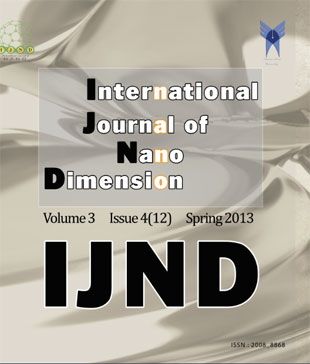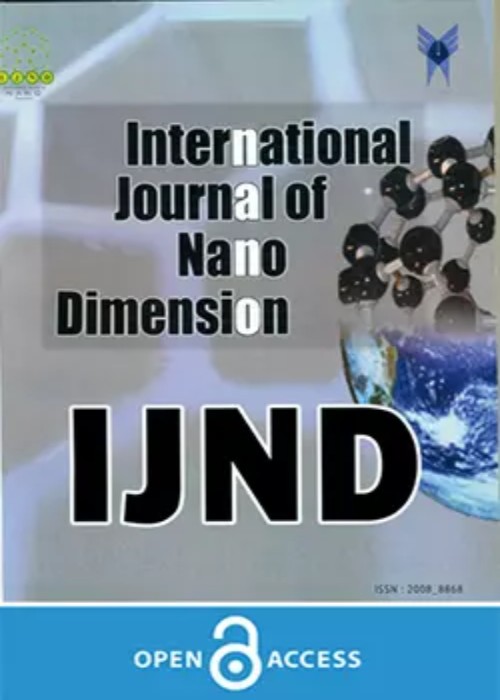فهرست مطالب

International Journal of Nano Dimension
Volume:3 Issue: 4, Spring 2013
- تاریخ انتشار: 1391/10/29
- تعداد عناوین: 11
-
Pages 255-262Silver nanoparticles with size of 6- 57nm were synthesized by bioreduction method from Anisochilus carnosus aqueous and ethanolic extract. Biosynthesized nanoparticles showed maximum antimicrobial activity against K. pneumonia (13±1.67mm), E.coli (13±1.97mm) and B. subtilis (13±1.07mm) followed by P. aeruginosa and minimum against S. aureus. The quantitative formation, characteristics and impurities of silver nanoparticles were studied using UV-Vis absorption spectroscopy, X-ray diffraction analysis, EDX spectrum, scanning electron microscopy (SEM) analysis. Based on this investigation these silver nanoparticles may be used in effluent treatment process for reducing the microbial load.Keywords: Anisochilus carnosus, Silver nanoparticles, Antimicrobial activity, SEM, EDX, XRD
-
Pages 263-269In this study adsorption of 1-chloro-4-nitrobenzene on single walled carbon nanotubes has been investigated. The effect of contact time, pH, initial concentration of 1-chloro-4-nitrobenzene, adsorbent dosage and temperature on its adsorption has been carried out in order to find optimum adsorption conditions. Adsorption isotherms and related constants were also determined. Results showed that contact time to reach equilibrium was 60 min at 25°C and after that a little change of 1-chloro-4-nitrobenzene removal efficiency was observed. The results show that maximum 1-chloro-4-nitrobenzene removal (81.9 %) obtained at pH of 6 and it decreased at higher initial 1-chloro-4-nitrobenzene concentration, lower adsorbent doses and lower temperature. Langmuir, Freundlich and Temkin isotherm models were used to test the equilibrium data. Adsorption test results revealed that 1-chloro-4-nitrobenzene adsorption on the studied adsorbents could be better described by Freundlich isotherm.Keywords: Adsorption, 1, Chloro, 4, nitrobenzene, Single walled carbon nanotube, Isotherms
-
Pages 271-279We have used Lithium Aluminum Hydroxide reducing method of silver nitrate to prepare heterogeneous silver-silica nanocomposite particles with thiol and amino groups serving to bind the Ag nanoparticles to the surfaces of the SiO2 nanoparticles. We examined products of these reductions using FTIR, SEM, XRD and UV-vis. spectroscopy. The SiO2 nanoparticles had diameters ranging from 70 to 90 nm; the Ag nanoparticles that formed on the surfaces of the SiO2 nanoparticles had an average size of ca. 15 nm.Keywords: Silver, silica heterogeneous nanocomposite, Lithium Aluminum Hydroxide, Thiol, Amino, XRD, SEM
-
Pages 281-288The fluid flow and heat transfer in a three-dimensional microchannel filled with Al2O3- water nanofluid is numerically investigated. The hybrid scheme is used to discretize the convection terms and SIMPLER algorithm is adopted to couple the velocity and pressure field in the momentum equations. The thermal and flow fields were analyzed using different volume fractions of nanoparticles and different Reynolds numbers. The temperature fields, the average Nusselt number on the bottom surface, the thermal resistance and the pressure drop were obtained from the simulations. Results indicated enhanced performance with the usage of nanofluids, and slight penalty in pressure drop. The increase in Reynolds number caused increase in the heat transfer rate as well as pressure drop and decrease in the thermal resistance.Keywords: Nanofluid, Microchannel, Convection heat transfer, Pressure drop
-
Pages 289-296Calcium fluoride nanoparticles with special amount of cerium ion (%1) were synthesized by coprecipitation. Fourier transforms infrared spectroscopy (FTIR), X-ray diffraction (XRD), absorption and photoluminescence (PL) from CaF2Ce nanoparticles has been investigated. FTIR spectra reveal that there are some amounts of OH, NO3 and other organic functional groups on the particle surfaces before the post annealing process. X-ray diffraction results indicate an improvement in crystalline quality with annealing. Intensity of fluorescent bands as well as the absorption edge of the prepared nanoparticles is also very relevant to the annealing temperature.Keywords: Coprecipitation, Nanoparticles, Calcium fluoride, Annealing, Photoluminescence
-
Pages 297-301In this paper, a novel method of producing bi-metallic alloy nanoparticles at low temperatures using hydrogen bombardment of thin films, deposited on glass substrates, is introduced. Optical and morphological characteristics of the nanoparticles were extensively studied for various conditions of plasma treatment, such as plasma power density, temperature, duration of hydrogen bombardment, thickness of the initial thin metallic film etc. As an important application of fabricated alloy nanoparticles, humidity sensor based on the alloy nanoparticles was introduced. It was shown that Ag-Cu alloy nanoparticles ionizing ability of the fabricated alloy nanoparticle is higher than Ag and Cu nanoparticles. Scanning Electron Microscopy, Atomic Force Microscopy and Transmission Electron Microscopy were used to analyze the nanostructures.Keywords: Nanoparticles, Plasma, Hydrogen, PECVD, Humidity sensor Ag, Cu, Alloy
-
Pages 303-312The effective removal of heavy metals from industrial wastewater is the most important issues for many industrialized countries and it is big challenge for human being. This research focuses on understanding adsorption process and developing a cost effective technology for treatment of heavy metals-contaminated industrial wastewater. In this investigation the Fe2O3 magnetic nano adsorbents are effective and posse’s high adsorption capacity and efficient removal rate. In this research article iron oxide nano adsorbents have been employed for the removal of Cd(II)ions from aqueous solutions by batch adsorption technique. The amount of Cd(II) ions adsorbed increases as temperature increased. The optimal pH values for Cd(II) ions removal was in between 5.5 to 6.5 different other parameters are also studied such as initial concentration of metals, catalyst dose, contact time etc. The kinetic study also have been investigated for this research article and it is observed that Cd(II) ions removed by Fe2O3 magnetic nano adsorbent obey pseudo first order and pseudo second order kinetics model effectively.Keywords: Cadmium, Magnetic nanoadsorbent, Iron oxide, Adsorption, Ferric oxide
-
Pages 313-319In this study, we describe the growth of carbon nanotubes on commercial iron nanoparticles without carbon shell (Fe (nm), size <60 nm) andiron nanoparticles with carbon shell (Fe* (nm), size <60 nm) as catalysts by chemical vapour deposition method. In order to investigation of supports effects, preparation of catalyst nanopowders (Fe* (nm)/Al2O3 and Fe* (nm)/MgO) was carried out by mixing commercial Fe* nanoparticles (as catalyst) with Al2O3 and MgO powders (as supports)by using ball-milling method. The results show in spite of the fact that ball-milling process can have negative effects on diameter and morphology of synthesized CNTs at 925 ˚C, but it could increase the range of growth temperature from 865 ˚C to 975 ˚C.Keywords: Ball, milling, Carbon nanotubes, Catalyst nanoparticles, Chemical vapor deposition
-
Pages 321-328The effects of adding Nano-Silica particles on the compressive strength and water permeability of concrete and its comparison with that of Micro-Silica were investigated in this work. The effect of combination of Nano- silica and Micro-silica were also studied in this work, which resulted in an increase in compressive strength of concrete in comparison with other concrete specimens tested in this study. In addition, it has been well shown that the concrete specimens made of Nano-Silica particles were more impermeable in comparison with other concrete mixes tested in this work. To study the microstructure of the concrete mixes some images were also taken by the scanning electron microscope (SEM), which has shown the ever more uniformity of the samples containing the Nano-particles compared with the control samples. The XRD analysis showed that the Ca(OH)2 amount of such samples is considerably less than that of the control sample.Keywords: Nano, silica, Concrete, Cement paste, Compressive strength
-
Pages 329-332In this paper energy bands and Berry curvature of graphene was studied. Desired Hamiltonian regarding the next-nearest neighbors obtained by tight binding model. By using the second quantization approach, the transformation matrix is calculated and the Hamiltonian of system is diagonalized. With this Hamiltonian, the band structure and wave function can be calculated. By using calculated wave function the Berry connection and Berry curvature of our system are calculated. Our results are exactly consistent with previous methods and the Berry curvature throughout the Brillouin zone get zero.Keywords: Graphene, Tight binding model, Band structure, Berry curvature, Brillouin zone
-
Pages 333-336In this paper, we investigate variation of the wavelength, intensity and polarization of the self-assembled InAs/GaAs quantum dots emission by microphotoluminescence spectroscopy at the liquid helium temperature. The microcavity wafer sample is grown by molecular beam epitaxy (MBE) and chemically etched into the micropillar structure (with elliptical cross section - long and short axis 2μm×1.5μm respectively). Two polarized modes of the micropillar and also quantum dot in the orthogonal axis of long and short diameters are considered and marked by H and V respectively. The analysis of the spectra shows that by increasing temperature, the quantum dot emission wavelength will be shifted towards longer wavelength, and at resonance wavelength of quantum dot and cavity confined modes which are red shifted less than quantum dot, enhancement would happen. Changes in emission wavelength and coupling of four individual quantum nanoparticles in the sample (with different spatial and spectral conditions) were studied in the temperature range ~ 5-50 K. Also, experiments show that the polarization amount and fine structure splitting for different quantum dots are different. The difference can be attributed to the deviations from the symmetric shape of quantum dots and the capping stage during next epitaxial growth. Polarization variability on- and off- resonance by changing temperature is also reported.Keywords: Quantum Dot, Microphotoluminescence, Microcavity, Polarization


